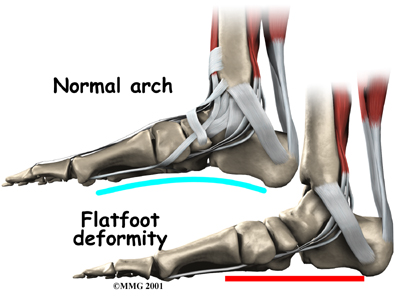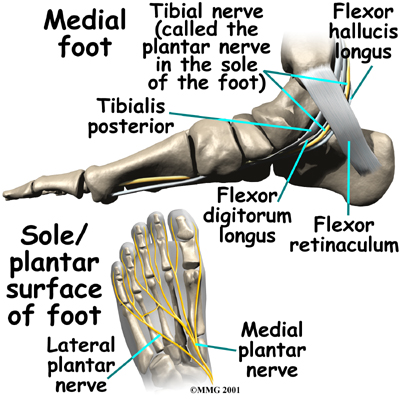Non-surgical Rehabilitation
Treatment for this condition depends on what is contributing to the pressure on the nerve. Our physiotherapist can direct treatments to the painful area that help to control pain and swelling, such as ultrasound, moist heat, and soft-tissue massage. Physiotherapy sessions sometimes include iontophoresis, which uses a mild electrical current to push anti-inflammatory medicine, prescribed by your doctor, into the sore area.
 Once the swelling and inflammation have improved, our physiotherapist can design a program of stretching exercises to improve flexibility in the calf muscles and to encourage the tibial nerve to glide within the tarsal tunnel.
Once the swelling and inflammation have improved, our physiotherapist can design a program of stretching exercises to improve flexibility in the calf muscles and to encourage the tibial nerve to glide within the tarsal tunnel.
People who have problems of (flattened arches) may need specialized inserts, called orthotics, for their shoes.
Pronation is a common condition in which the inside edge of the foot rolls in, causing the arch to flatten. When this happens, the tibial nerve within the tarsal tunnel can become stretched.
If your tarsal tunnel syndrome is being aggravated by an abnormal position of the foot such as pronation, our physiotherapist may recommend to relieve the problem. Orthotics worn inside your shoe can help support the arch and take tension off the tibial nerve.

If your symptoms fail to respond to nonsurgical treatments, surgery to relieve the pressure on the tibial nerve may be suggested.
Post-surgical Rehabilitation
Pain and symptoms generally begin to improve with surgery, but you may have tenderness in the area of the incision for several months after the procedure.
Your ankle will be supported in a plaster splint for about 10 days after surgery. To help you begin your recovery, the physiotherapists at Emerald Hills Physio & Sports Clinic in can teach you how to properly use crutches to keep from placing weight on your foot while you stand or walk.
You will be advised to keep the dressing on your foot until you return to your doctor for follow up, and to avoid getting the stitches wet. Your stitches will usually be removed 10 days after surgery, at which time you will switch to a supportive walking boot.
Your physiotherapist in Sherwood Park will advise you to take time during the day to support your leg with the ankle and foot elevated above the level of your heart to promote the decrease of swelling. You will also be encouraged you to move your ankle and toes occasionally during the day.
Our physiotherapist may use ice packs, soft-tissue massage, and hands-on stretching to help with the range of motion in your ankle. When your stitches are removed, you'll begin doing exercises to help strengthen the muscles that support the ankle and arch. We may also use special stretches to encourage the tibial nerve to slide inside the tarsal tunnel.
When you are ready, our physiotherapist will provide you with new exercises designed to get your leg and ankle working in ways that are similar to the activities you do every day, such as rising on your toes, walking, and going up and down stairs.
Although the time required for recovery is different for each person, as a guideline you may expect to attend physiotherapy sessions for up to eight weeks after surgery, with full recovery taking several months.
When your recovery is well under way, your regular visits to Emerald Hills Physio & Sports Clinic will end. Although we will continue to be a resource, you’ll eventually be in charge of doing your exercises as part of an ongoing home program.
Emerald Hills Physio & Sports Clinic provides services for physiotherapy in Sherwood Park.



 In many cases, doctors aren't sure what causes tarsal tunnel syndrome. Inflammation in the tissues around the tibial nerve may contribute to the problem by causing swelling in the tissues and
In many cases, doctors aren't sure what causes tarsal tunnel syndrome. Inflammation in the tissues around the tibial nerve may contribute to the problem by causing swelling in the tissues and  Once the swelling and inflammation have improved, our physiotherapist can design a program of stretching exercises to improve flexibility in the calf muscles and to encourage the tibial nerve to glide within the tarsal tunnel.
Once the swelling and inflammation have improved, our physiotherapist can design a program of stretching exercises to improve flexibility in the calf muscles and to encourage the tibial nerve to glide within the tarsal tunnel.
